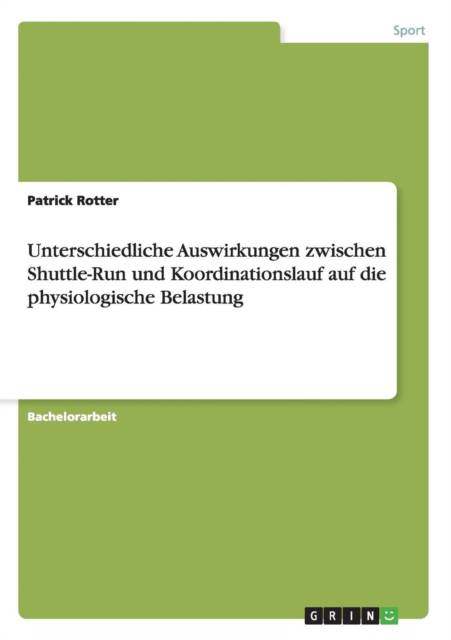
- Afhalen na 1 uur in een winkel met voorraad
- Gratis thuislevering in België vanaf € 30
- Ruim aanbod met 7 miljoen producten
- Afhalen na 1 uur in een winkel met voorraad
- Gratis thuislevering in België vanaf € 30
- Ruim aanbod met 7 miljoen producten
Zoeken
Unterschiedliche Auswirkungen zwischen Shuttle-Run und Koordinationslauf auf die physiologische Belastung
Patrick Rotter
Paperback | Duits
€ 23,45
+ 46 punten
Omschrijving
Bachelorarbeit aus dem Jahr 2014 im Fachbereich Gesundheit - Sport - Sonstiges, Note: 2,0, Universität Salzburg (Sport science & kinesiology - PARIS LODRON UNIVERSITÄT SALZBURG), Sprache: Deutsch, Abstract: The purpose of this study was to examine physiological and performance differences between two intermittent interval tests, a shuttle-run (S) and a test with coordinative and perceptual demands (C). Five team-sport players (Mean+SD: age 21,6 ± 1,7 years, height 175,6 ± 3,9 cm, weight 72,8 ± 3,2 kg, sports experience 11,4 ± 3,1 years and practice hours/week 8,4 ± 2,9 h/w) performed in random order for three weeks. These tests consisted of three series, each of 5 x 20 seconds sprints with 40 seconds passive recovery. Heart rate (HR), oxygen uptake (VO2), blood lactate (La) were recorded and time-motion analysis was conducted. There was no significant difference in HR or VO2. In S La was increasing over all three series whereas in C, La only increased until the second series and remainded steady during the third one. Distribution of intensities (high, middle, low) was in C similar to the findings in other studies of time-motion analysis in team-handball and basketball. In conclusion, the test with coordinative and perceptual demands is very similar to the demands of the most team-sports and can easily be utilized as a field test and included in team- sports training.
Specificaties
Betrokkenen
- Auteur(s):
- Uitgeverij:
Inhoud
- Aantal bladzijden:
- 28
- Taal:
- Duits
Eigenschappen
- Productcode (EAN):
- 9783668080096
- Verschijningsdatum:
- 25/11/2015
- Uitvoering:
- Paperback
- Formaat:
- Trade paperback (VS)
- Afmetingen:
- 148 mm x 210 mm
- Gewicht:
- 49 g

Alleen bij Standaard Boekhandel
+ 46 punten op je klantenkaart van Standaard Boekhandel
Beoordelingen
We publiceren alleen reviews die voldoen aan de voorwaarden voor reviews. Bekijk onze voorwaarden voor reviews.








